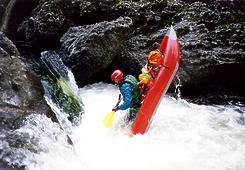|
Safety |
|
DisclaimerWhitewater paddling should be undertaken only by groups of individuals who have prior training and adequate equipment. The authors assume no liability for accidents that might occur in the pursuit of activities based on their river descriptions. All kayakers and rafters share a common interest in freedom of navigability and river preservation. See a summary of California navigability law. Safety TalkWhitewater boating can be a death-defying sport. Although the kayaking injury rate is substantially lower than for snow skiing, the fatality rate is higher, in fact about the same as for driving a motor vehicle. Of course vehicular statistics include drunk driving, whereas kayaking statistics presumably do not, so kayaking is probably more dangerous than sober driving during daylight hours. One way to improve safety is to have this guy, Mike O'Shea, on any trip you take. He can lead you down the best routes, run a difficult drop first to make sure it is safe, and rescue you from many hazardous situations. Unfortunately Mike is booked most of the time. Another way to improve safety is to think for yourself. Few other sports involve such a large component of self-reliance. Almost all river hazards can be observed or predicted by careful scouting, either from your boat or from the river bank. Never enter a rapid if you have not seen to the bottom, because unknown hazards (such as logs) might lurk there. Learn to recognize the warning signs of undercuts and entrapment points. Mishaps occur, so rescue and self-rescue skills are important. Always wear a helmet and high-flotation PFD, even when bank scouting. If you fall out of your boat, get back in as quickly as possible. If your boat tips over, flip it right side up and climb back in. If you're still in the midst of a big rapid, crawl on top of the overturned boat. Here are some books you can read to learn more about paddling and rescue:
According to AWA (American Whitewater Affiliation) statistics, 25% of kayaking fatalities are attributed to boat pins, 25% to long swims, 11% swimming into trees, 9% boating into trees, and 4% to foot entrapment. Because inflatable kayaks are not suitable for high water, and never pin with you inside the boat, your chances of dying are reduced by 50% if you IK at low or moderate flows only. Entrapments, especially swimming or boating into trees, and foot entrapment while swimming, are your major concerns. Always steer clear of trees in the water, especially when swimming. If you swim into a log, crawl aggressively on top of the log (this is difficult because the force of the water pushes you under). Take a swiftwater rescue course to practice this skill. If you boat into a log, climb out of your boat onto the log. When swimming, keep your feet up so they don't get caught on the river bottom. If they do, try turning sideways or backwards to free your foot. Hopefully your buddies on opposite shores will set up a weighted throwbag tied to another and drag your trapped leg upstream (this procedure is described in rescue books). For a poignant short story about how survivors feel, read The Name of the Edge by Grateful Ed. Please boat safely. Bibliography(Slightly inter)National AWA River Inventory by the American Whitewater Affiliation. Jim Cassady and Fryar Calhoun, California Whitewater - A Guide to the Rivers, for rafters and kayakers, North Fork Press, Berkeley, 3rd edition, 1995. Ann Dwyer, Easy Waters of California - North, for canoeists and kayakers who are not adrenelin junkies, GBH Press, Windsor CA, 2nd edition, 2000. Lars Holbek and Chuck Stanley, Guide to The Best Whitewater in the State of California, mostly for kayakers, Friends of the River Press, 3rd edition, 1998. Charles Martin, Sierra Whitewater - A Paddler's Guide to the Rivers of California's Sierra Nevada, Martin Press, outdated and out of print, 1974. Dick Schwind, West Coast River Touring - Rogue River Canyon and South, Touchstone Press, out of print but still useful, 1974.
|
Creeks NavigationHomeRecommended Runs Map of Rivers Alphabetic Index Alphabetic Table Text Search
Sponsored Links
|

